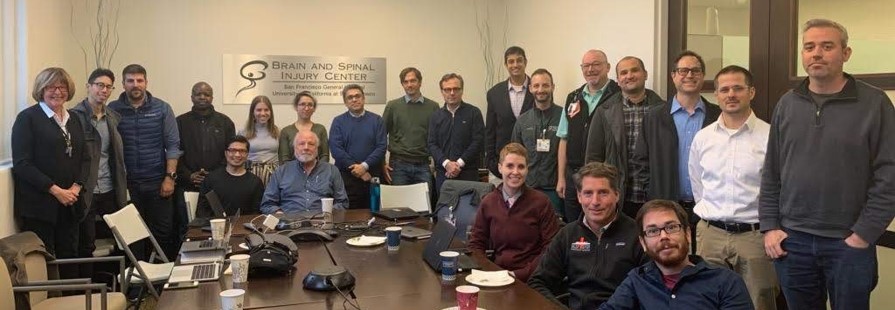Spinal Cord Injury
TRACK-SCI: Leveraging Fundamental Clinical Discoveries to Guide Treatment and Improve Recovery after Spinal Cord Injury



Posted January 13, 2021
 Dr. Michael Beattie
Dr. Michael Beattie
Spinal cord injuries (SCIs) often cause devastating, life-long impairments in limb movement, breathing, eating, sexual function, bowel/bladder function, and psychosocial well-being. Physicians have to make critical decisions to coordinate care in the first hours to days following injury as the spinal cord is vulnerable to further damage. This is uniquely difficult because there is a lack of resources available to guide these time-sensitive decisions, which can often have a huge impact on injury outcome and recovery. To address this, a multi-institutional team of researchers led by Dr. Michael Beattie, Professor of Neurological Surgery at the University of California, San Francisco (UCSF), developed the infrastructure for a database of SCI patient information termed TRACK-SCI (Transforming Research and Clinical Knowledge in SCI). The clinical SCI team is led by neurosurgeon Dr. Sanjay Dhall, and the data team by Dr. Adam Ferguson. With support from the Spinal Cord Injury Research Program (SCIRP) across multiple awards totaling just under $5 million, the research team collects patient demographics, treatments, and outcomes, which will help inform researchers as to the most impactful clinical care strategies to support meaningful recovery.
Prior to the establishment of TRACK-SCI, the UCSF-base team analyzed historical patient data and rodent models, revealing relationships between severe post-injury hypotension and hypertension (i.e., low vs. high blood pressure, respectively) and poor neurological outcomes. This work was funded under a fiscal year 2012 (FY12) SCIRP grant (W81XWH-13-1-0297), and established blood pressure management via vasopressor administration as a potential strategy to improve early outcomes after SCI in both humans and rodents.1-4 Indeed, management of blood pressure immediately after SCI has now become standard of care. Despite this, there are several complications for vasopressor treatment. For example, while the optimal blood pressure to prevent secondary injury may be patient-specific, clinical guidelines are not. Additionally, vasopressor treatment on its own can be damaging to the heart, especially in elderly patients. This is only one example of the many treatment decisions clinicians need to make during early injury management, which is complicated further by the lack of knowledge regarding early SCI physiology. Thus, the team identified the need to develop noninvasive, quick-to-collect, biomarkers to guide personalized treatment plans for those with SCI.
Based on these early studies and the need to develop a sustainable framework from which to track and share patient outcomes, Dr. Beattie and his team developed TRACK-SCI under a FY15 SCIRP grant (W81XWH-16-1-0497). TRACK-SCI initially involved a 3-year observational study documenting the effectiveness and diagnostic value of the BASIC MRI score, hemodynamic treatments (e.g., controlling blood pressure), surgical decompression, and spinal perfusion pressure protocols during early treatment of SCI at two clinical sites, the UCSF Brain and Spinal Injury Center at Zuckerberg San Francisco General Hospital, and UCSF Fresno Medical Center (led by neurosurgeon Dr. Yu-Hung Kuo). This initial TRACK-SCI study further affirmed the diagnostic utility of the BASIC MRI-based score in predicting patient outcomes following SCI, thus informing subsequent treatment statagies.5-7 Moreover, observational and clinical intervention studies revealed the importance of early surgical decompression and spinal cord perfusion pressure maintenance over current clinical standards focused only on blood pressure management.8,9 In a preliminary report, Dr. Dhall and the team shared the promising results of using spinal cord perfusion pressure maintenance to improve functional and sensory recovery after SCI. In this study, after spinal cord perfusion pressure maintenance for 5 days post-injury, 50% of patients with impairment due to their spinal cord injury presented with functional and sensory improvement.9
TRACK-SCI was recently expanded upon in a FY19 Expansion Award from SCIRP (W81XWH-20-1-0245). This award includes the collection of patient data from a third clinical site, the Ohio State University Wexner Medical Center, led by Drs. Frank Farhadi and Jan Schwab, making this database a truly multi-institutional, multi-state effort. The expansion also builds on the use of patient blood to identify biomarkers of SCI severity. Using changes in gene expression within blood cells as a predictive biomarker is particularly attractive, as blood is easy to collect and can be analyzed quickly, thus allowing for faster decision-making that can save lives and lead to better patient outcomes. In a pilot study examining the potential of a blood biomarker, 197 gene alternations were discovered in the blood of individuals who suffered an SCI, as compared with healthy and trauma control participants. Several of these genes predicted later injury severity with an overall accuracy of ~72%.10 Further characterization of blood biomarkers also has the potential to reveal fundamental mechanisms underlying the physiology of early injury in those with SCI. With the support of this new award, a more robust and sharable patient database will be utilized by researchers and clinicians across different institutions to allow for further discoveries to improve SCI patient care.
Arguably, the most impressive aspect of TRACK-SCI is their integrative cross-institutional team, with collaboration among a diversity of clinical decision makers, data scientists, and researchers. The research team, comprised of both human (clinical) and animal (preclinical) researchers, uses the human data collected to develop rodent models that more accurately mimic human injury for the purpose of examining basic biological mechanisms of SCI and testing novel therapeutic regimes. The recent expansion of TRACK-SCI also adds consumer advocates with lived SCI experience to the research team. These integral team members will now be able to provide a patient’s perspective as the researchers begin analyzing and expanding the TRACK-SCI database (see insert below). Together, this unique team will continue to make discoveries fundamental to SCI physiology, early injury management strategies, and identify clinically relevant biomarkers, all while providing a comprehensive roadmap for the collaborative future of SCI research and care.
 TRACK-SCI Team Photo.
TRACK-SCI Team Photo.
SCI-Lived Experience Consultants (SCILEs): One of the most exciting inclusions in the new TRACK-SCI Expansion Award from SCIRP is the addition of consumer advocates in the form of SCI Lived-Experience Consultants (SCILE) to the research team. Beginning in FY19, SCIRP mandated that research teams must include people with lived SCI experience who will provide advice and consultation throughout the planning and implementation of the research project. This gives an important seat at the table to the SCI community and, most importantly, gives those with SCI access to active researchers and clinicians, spurring new possibilities in guiding research programs and improving patient advocacy. For example, SCILEs are being used in patient-facing capacities, such as participant enrollment, focus groups, project promotion, and the sharing of results to the broader community. This is an important role because it can facilitate making studies more accessible and directly relevant to the needs of the SCI community.
 Chris Barr
Chris BarrTRACK-SCI SCILE
One of the SCILEs for the TRACK-SCI expansion, Chris Barr, is particularly excited to join the team. Chris was a previous TRACK-SCI study participant after breaking his neck surfing in San Francisco. Chris said that in his role as a SCILE, he hopes to be able to “translate the urgency of certain aspects of SCI and the need for targeted research, and communicate with the research team the elements that are important to a person with SCI.” Chris will meet regularly with the research team to provide input on aspects of the patient database that are most relevant to people with SCI, project design, disseminating results, and patient-relevant advocacy for aspects of the research process. Inclusion of SCILEs like Chris on the team is so important because researchers can inadvertently be far removed from the community they are trying to help, and thus SCILEs can provide a crucial community-relevant perspective. SCIRP looks forward to monitoring and assisting in the integration of SCILEs into our research grants and the broader research community.
Selected Publications:
- Hawryluk G, Whetstone W, Saigal R, et al. 2015. Mean arterial blood pressure correlates with neurological recovery after human spinal cord injury: Analysis of high frequency physiologic data. J Neurotrauma. 2015 Dec 15; 32(24):1958-1967. doi: 10.1089/neu.2014.3778
- Catapano JS, Hawryluk WJ, Whetstone W, et al. 2016. Higher mean arterial pressure values correlate with neurologic improvement in patients with initially complete spinal cord injuries. World Neurosurg. 2016 Dec; 96:72-79. doi: 10.1016/j.wneu.2016.08.053
- Inoue T, Manley GT, Patel N, and Whetstone D. 2013. Medical and surgical management after spinal cord injury: vasopressor usage, early surgerys, and complications. J Neurotrauma. 2014; 31(3):284-291. doi: 10.1089/neu.2013.3061
- Nielson JL, Paquette J, Liu AW, et al. 2015. Topological data analysis for discovery in preclinical spinal cord injury and traumatic brain injury. Nat Commun 6:8581. doi: 10.1038/ncomms9581
- Haefeli J, Mabray MC, Whetstone SS, et al. 2017. Multivariate analysis of MRI biomarkers for predicting neurologic impairment in cervical spinal cord injury. AJNR Am J Neuroradiol. 2017 Mar; 38(3):648-655. doi: 10.3174/ajnr.A5021
- Mabray MC, Talbott JF, Whetstone D, et al. 2016. Multidimensional analysis of magnetic resonance imaging predicts early impairment in thoracic and thoracolumbar spinal cord injury. J Neurotrauma. 2016 May 15; 33(10):954-962. doi: 10.1089/neu.2015.4093. Epub 2016 Feb 1. PMID: 26414451; PMCID: PMC4876497.
- Talbott JF, Whetstone WD, Readdy WJ, et al. 2015. The Brain and Spinal Injury Center score: A novel, simple, and reproducible method for assessing the severity of acute cervical spinal cord injury with axial T2-weighted MRI findings. J Neurosurg Spine. 2015 Oct; 23(4):495-504. doi: 10.3171/2015.1.SPINE141033
- Burke JF, Yue JK, Ngwenya LB, et al. 2019. Ultra-early (<12 hours) surgery correlates with higher rate of American Spinal Injury Association impairment scale conversion after cervical spinal cord injury. Neurosurgery. 2019 Aug 1; 85(2):199-203. doi: 10.1093/neuros/nyy537
- Yue JK, Hemmerle DD, Winkler EA, et al. 2020. Clinical implementation of novel spinal cord perfusion pressure protocol in acute traumatic spinal cord injury at U.S. level I trauma center: TRACK-SCI study. World Neurosurg. 2020 Jan; 133:e391-e396. doi: 10.1016/j.wneu.2019.09.044
- Kyritsis N, Espin AT, Schupp PG, et al. 2020. Blood RNA profiles are diagnostic for severity in human acute spinal cord injury. bioRxiv 2020.04.15.037325; doi: 10.1101/2020.04.15.037325
Links:
Spinal Cord Injury Research Program (SCIRP) at CDMRP
Public and Technical Abstracts: Early Critical Care Decisions and Outcomes after SCI: TRACK-SCI
Last updated Thursday, December 5, 2024














